How To Do 1 Rep Max Test
In forcefulness grooming, a 1-rep max (1RM) is about much more than bragging rights. Knowing the maximum amount of weight you can lift isn't just about getting likes on Instagram. A 1RM is a landmark for quality programming, conditioning, and training.
When it comes to consequent force training, knowing your 1RM (or at least an estimate) helps dictate multiple grooming variables and a programme's flow. This provides direction for micro, meso, and macrocycles (AKA brusk-term, long-term, and fifty-fifty longer-term training cycles). It also helps lifters push button their potential from a strategic point of view. If you know what numbers you're aiming to striking, y'all can plan — and crush — your preparation accordingly.
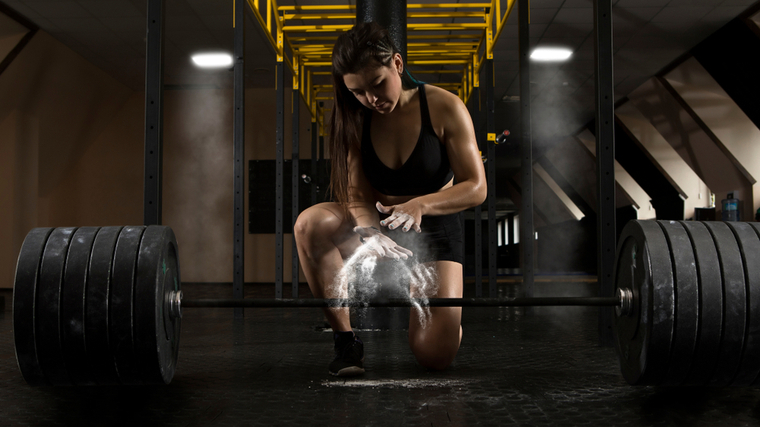
Hither, you'll larn everything y'all want to know about finding your 1RM, including whether maxing out is correct for you and how to estimate your big numbers if it's not.
- What is a 1RM?
- Benefits of Knowing Your 1RM
- Who Should Know Their 1RM
- How to Find Your 1RM
- 1RM Calculator
- Who Should Max Out
- Who Shouldn't Max Out
- How to Work Upward to Your 1RM
- Frequently Asked Questions
1RM Video Guide
BarBend's former Fitness Editor, Jake Boly, walks yous through all there is to know about 1-rep maxes in the video below!
What Is a 1RM?
Your 1RM is the accented maximum corporeality that y'all tin can lift for one rep of any given do. A true 1RM will get out you with nix in the tank. You'll have the internal feeling of, "I couldn't add more than weight to the bar if I tried."
Technically, you can notice your 1RM for any movement, non merely compound exercises and big competition lifts. However, while you could find your 1RM for, say, barbell curls, it'southward worth noting that not all 1RMs will carry the aforementioned weight when information technology comes to directing strategic programming.
Plus, maxing out with smaller, more vulnerable muscle groups may increase injury risk while eating into recovery. That may prevent you lot from getting stronger overall with bigger chemical compound lifts. In that way, some exercises are just not worth maxing out due to the run a risk:advantage ratio that comes along with them.
When because which lifts to determine your max for, remember about your competition lifts. For weightlifters, that will exist the snatch and the clean & wiggle. For powerlifters (and sometimes strongmen and CrossFitters), it's going to exist the squat, bench printing, and deadlift. Strongman and strongwoman athletes might also need to know their log press max, which y'all can also generalize into learning your overhead press 1RM.
Benefits of Knowing Your 1RM
At that place are handfuls of benefits that come up with knowing your 1RMs and using them strategically. These benefits will slide and shift based on one's goals, needs, and overall training feel.
Better Programming
The starting time do good of knowing or having an estimate of your 1RM is that it facilitates better programming. A great programme will be structured to progress force and adaptations strategically. Knowing your 1RM in the relevant lifts can assistance dictate flow of grooming within:
- Macrocycles: Annual or yearly scope of training;
- Mesocycles: 2-6 calendar week blocks that are designed to accommodate various adaptations; and
- Microcycles: 1-2 weeks of training that take a very specific focus.
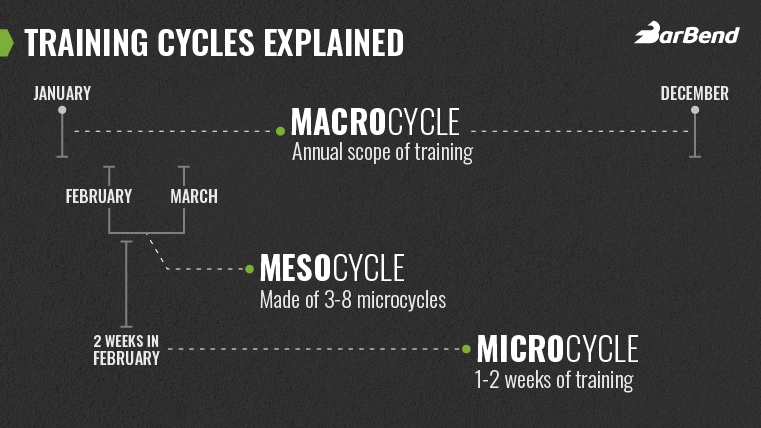
Inside these timelines, programs will frequently apply autoregulatory methods similar determining your rate of perceived exertion (RPE). When you base your grooming in RPE, you guess how difficult a specific weight was to lift on scale of one to 10 (10 being accented max effort). The basic premise here is listening to your body and adjusting your weights accordingly.
All the same, many lifters volition also want to apply percentages and auto-regulation together to provide the best scope for strategic training. The per centum hither refers to what percent of your 1RM you should be lifting each week. Without knowing your 1RM (whether verbal or guess), it'south incommunicable to practice this accurately.
Guiding Daily Workouts
Knowing your 1RM for unlike lifts can help directly your grooming. When you're going over your programming, 1RMs can assistance provide a better lay of the state for where your torso is at.
When you're lifting at a sure level, you might be leaving gains on the table if yous don't know your 1RM and programme accordingly. You take a chance either not challenging yourself enough to make gains or burning yourself out if yous push the intensity likewise loftier, too oftentimes. To say the to the lowest degree, that is less than ideal for longevity in the gym. Beingness enlightened of your 1RM gives yous guidelines for knowing how hard to push, how often.
Who Should Know Their 1RM?
While knowing your 1RM in various compound lifts can be of import for the management of your programming, it's not a necessity for anybody — especially those who don't have strength-focused goals. Then who needs know their true 1RM?
Beginners
For near beginning lifters, knowing their 1RM isn't incredibly of import because building a foundation of strength and course should take precedence over your numbers. Having a loose thought of your 1RM can be useful — hence, using estimates — but truly maxing out before you're mechanically proficient tin can be counterproductive.
If you lift as well much also before long, you risk performing a movement with poor class. In the best case scenario, the motion will be rendered ineffective. At worse, you'll hurt yourself.
Intermediates
Intermediate lifters tin can do good from knowing their 1RMs. All the same, there is a large divergence between intermediate lifters with merely over vi months of experience and intermediate lifters with a year and a half of feel. Considering this factor can help direct which type of 1RM testing volition exist virtually beneficial.
If you don't take ambitions for always testing your truthful 1RM strength or competing, you lot can simply use estimates and calculations to best direct your training and intensities. On the other hand, if y'all're an intermediate lifter that wants to compete and button yourself to the limit, you lot might benefit from testing your true 1RMs.
Advanced and Competitive Strength Athletes
This one is a no-brainer. Avant-garde lifters and competitive forcefulness athletes don't only benefit from knowing their 1RM — they need to know and exam 1RMs at meets. Competitive s trength athletes take to know their 1RMs to program for competition and to create realistic goals. Generally, true 1RMs will exist the all-time bet for this blazon of lifter.
Fifty-fifty bodybuilders may want to examination their maxes. The kinds of high-intensity training involved in testing 1, three, and five-rep maxes can help bodybuilders maintain their strength during a nutrition.
However, if you're a competitive athlete in a non-strength sport, you will likely non need to test or know your true 1RM. In that case, you lot can get away with using heavy doubles, triples, or even sets of five to help determine your estimated 1RM. The risk:reward usually isn't there for elite sport athletes who tin can't afford to risk injury on the platform when they need to leave information technology all out on the field.
How to Find Your 1RM
Just considering yous should know your 1RM for daily grooming purposes doesn't mean yous should actually test it. There are a few ways to detect 1RMs and each method should be chosen based on a few unlike factors. Mainly, you'll take into consideration your preparation age, goals, and individual needs. These volition aid you determine whether you should examination your bodily 1RM with max out days or utilize a 1RM reckoner to get your estimated 1RM.
These are three main methods you tin apply to find your 1RM:
- Max Out Days
- Estimating Your 1RM in the Gym
- Estimating Your 1RM With 1RM Calculators
Max Out Days
The first method for finding your 1RM is with a 1RM testing day. These are days where there'south i goal in heed — maxing out a desired lift or lifts.
For truthful 1RM testing days, you'll have to blueprint your program around building up to the big twenty-four hour period. Y'all'll need to prep both your body and your mind for maximal results. Way alee of fourth dimension, you should know what lifts you're planning to max out with. You lot might choose to practise them all on one day, as with a simulated competition, or split your max lifts over multiple days.
You'll also want to make certain you're warming upwardly according to the increasing intensities of your workouts. Is your warm-up dialed in and adjusted to prep your body for maximal intensities? Do yous accept spotters and proper equipment to go on yous rubber during max attempts?
1RM Testing Pros
- These tests volition provide the about accurate idea for where your 1RM is sitting.
- Your results will hold upwardly longer than calculations and add even more accuracy to your programming.
- Testing your true max will increment your experience and confidence under the bar when moving weight at this caliber.
- If you compete in a forcefulness sport, such as powerlifting, strongman, or Olympic weightlifting, yous need to acquire a taste for being under maximally heavy loads.
1RM Testing Cons
- Finding your true 1RM is very mentally and physically draining, and so business relationship for this earlier programming max days.
- You lot may not accept access to spotters or the proper equipment you need to keep yourself condom.
1RM Testing Tips
Every athlete volition have their own listing of tips and processes for structuring 1RM testing days. Only from visualization to resting between sets, check out some general tips for maxing out.
- Rest before this twenty-four hours
- E'er use spotters
- Don't underestimate mental preparation and visualization tactics
- Structure max out days loosely similar to contest formats
- Program your exercises according to their difficulty
- Accept some rest in between consecutive max out days
- Rest in betwixt sets
Estimating Your 1RM in the Gym
If you're a beginner or less-experienced intermediate lifter, you might not want to test your true 1-rep max. Yet, it'due south advisable to have an approximate for training purposes. There are 2 main ways to estimate your max. The first style to guess your 1RM is to do and then in the gym, and the 2d is with a 1RM estimator.
When you want to estimate your 1RM in the gym itself, you don't take to really grind through a unmarried-rep PR. Based on your experience level, yous can use a well-structured preparation mean solar day and the reckoner on your phone to grab an estimate of your max.
1RM Estimate Pros
- You'll introduce yourself to the psychology of a testing mean solar day, even if you're not going all the style at that place.
- Estimating your max based on your lifts in the gym tin can brand your calculations more than authentic.
- In that location's less of an injury risk when y'all aren't going all out, and you won't have to peak as strictly as you lot exercise when really maxing out.
1RM Estimate Cons
- Y'all won't have the same opportunity to feel a true 1RM grind.
- This method is by nature not as authentic as an actual max effort.
1RM Gauge for Beginners
Subsequently a thorough warm-up, follow the below protocol to find your 1RM approximate. Utilize moderate weight jumps that you feel confident with, and just go up when your form is solid.
- 10 reps 10 barbell only
- 8 reps ten low-cal weight
- six reps x moderately-heavy weight
- 5 reps ten heavier weight
- five reps x heavier weight
- v reps x heavier weight
You lot'll and so take your final five-rep weight and multiply it by the 1.15, per the advice in the Essentials of Forcefulness and Conditioning 4th Edition.So, your v-rep weight 10 1.15 = estimated 1RM.
1RM Estimate for Intermediate Lifters
When y'all accept more than lifting feel nether your below (more six months, but less than a year and a half), you'll be more familiar with your trunk and how it reacts to different training stimuli. Y'all're also more probable to have a sense of how to approximate your RPE during a given rep or set.
If that sounds like you, endeavor this protocol afterwards a thorough warm-upward.
- x reps ten barbell merely
- 8 reps 10 55% 1RM or 5 RPE
- half-dozen reps x 65-70% or 7 RPE
- 3 reps x 77% or eight RPE
- three reps 10 87% or 8.5 RPE
- three reps x 94% or 9 RPE
- 3 reps x 95+% or ten RPE
From there, whip out your phone'due south calculator and toss in this equation, per the Essentials of Force and Conditioning fourth Edition: 3 -rep weight X i.08 = estimated 1RM.
Estimating Your Max with 1RM Calculators
Some other popular manner to detect 1RMs is with the employ of 1RM calculators. This a keen choice for beginners and intermediates because they can provide a baseline level for directing your training and programming.
For those interested in using 1RM calculators to establish an estimate for their 1RM, the requirements are much lower. You just need a cognition of a few heavy double, triple, or 4-rep sessions for a desired lift. The reality is, yous only need one number to plug into the calculator. Still, having a few numbers to pull from tin can increase accuracy.
1RM Estimator Pros
- These calculators are easy to utilise and more accessible than gym estimates might be.
- With a 1RM figurer, you lot tin can get preparation direction for populations that are not nevertheless gear up to fully max out.
1RM Calculator Cons
- This method is non as accurate as truly maxing out.
- You won't necessarily go to feel the specific sensation of testing yourself on a particular day.
1RM Estimator Popular Equations
When it comes to 1RM calculators, there are multiple equations that can be used. The two well-nigh popular tend to exist the Brzycki and Baechle formulas.
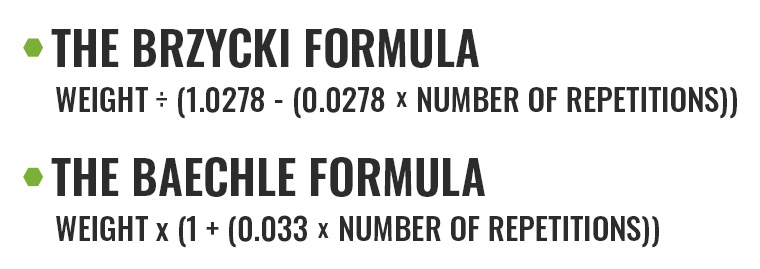
1RM Calculator Tips
Despite calculators being easy to employ, there are a few things to continue in mind when using them.
Call back, a calculator can always have some discrepancies when it comes to accuracy. The tips below can help ensure you're obtaining the best estimate for your 1RM.

The goal with calculators is to find an average and use that to direct your training, equally this will provide more accuracy.
1RM Reckoner
To test your 1RM, cheque out the BarBend one-rep max calculator beneath.
One Rep Max Figurer
Weight Lifted
Reps Performed
Your i rep max is:
| Percent of 1RM | Lift Weight | Repetitions of 1RM |
|---|---|---|
| 100% | 1 | |
| 95% | 2 | |
| xc% | 4 | |
| 85% | vi | |
| 80% | 8 | |
| 75% | nine | |
| 70% | 12 | |
| 65% | 16 | |
| 60% | 20 | |
| 55% | 24 | |
| fifty% | 30 |
Who Should Max Out
For a lot of lifters, maxing out is i of the most heady parts of their conditioning program. For people whose main goal is to build strength and add numbers to their lifts, they might exist eager to become later on their heaviest possible singles.
Experienced, Non-Competitive Lifters
If you take a lot of experience with lifting heavy weight — above 85 percentage of your max weight — you might look frontwards to testing your 1RM. Merely if you're non competing, it might be tempting to effort to take yourself to your limits pretty much whenever your warm-ups feel good.
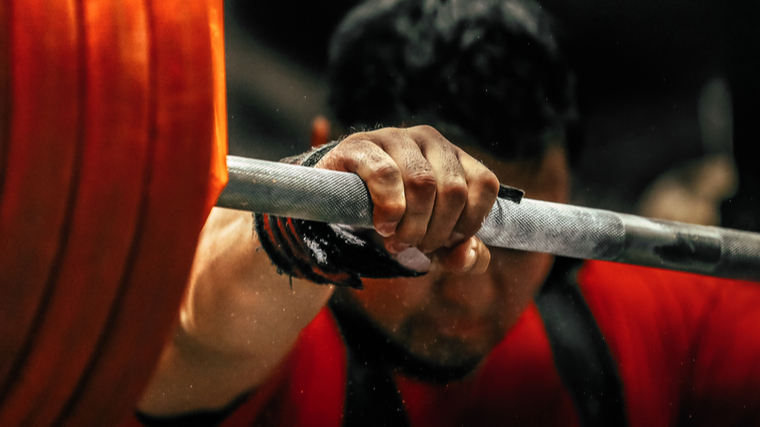
Merely if you bump upwardly the weight toward a max every time y'all feel skilful on your starting time working set, you'll be risking injury. Non only that, only you won't exist testing your true max if you lot oasis't peaked appropriately for it. So, for non-competitive lifters, plan information technology out like a contest — even merely with yourself. Schedule out no more than two or three times to max out per year so you tin can adequately prep and peak for your effort.
Competitive Strength Athletes
If you compete, the whole idea is that y'all'll max out. Some competitive athletes might want to save their biggest efforts for their meets. Other times, force athletes will max out in their own gyms, on their own time. Why? During training (as opposed to in competition), weightlifters and powerlifters are lifting on their own turf with their own timing, without the pressures and constraints of competition. They're also not mostly cutting weight during regular training cycles, so they might be able to hit even heftier weights.
Who Shouldn't Max Out
It's important for all kinds of lifters to take a working approximate of their 1RM. But that doesn't mean everyone should actually go for an all-out endeavour on the platform. Instead, these lifters might want to base their preparation plans on their estimated 1RM.
Start Lifters
A lot of start lifters volition start off learning exercises and practicing in the eight to 12 rep range. That'southward an appropriate range for moderate weights that you can use to both build muscle and do your technique. At that rep range, you'll build up enough volume to develop the musculus memory y'all need to become proficient at the exercises you're practicing.
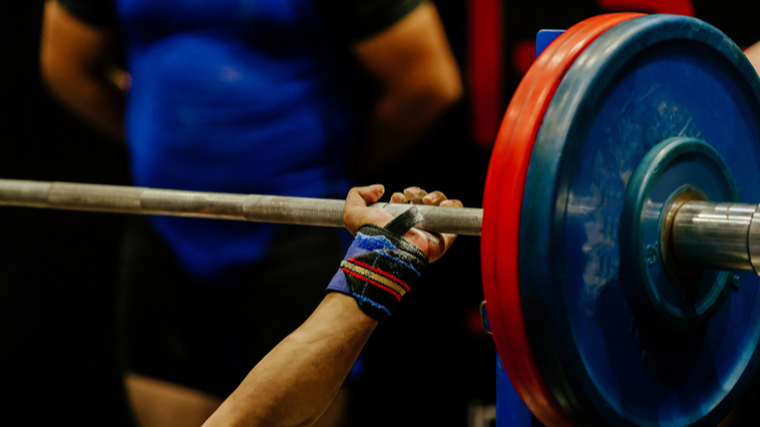
Newbie gains notwithstanding, you're not going to want to max out while y'all're still in your get-go six months to year or then of lifting — at the very least. You lot need to build a stronger base of forcefulness first. You as well need to develop the mental and physical focus you need to not allow your course pause down under force per unit area.
Strength Athletes with Upcoming Competitions
If y'all're training with a specific competition in heed, your programming and peaking should usually exist geared toward doing besides as you tin. In those cases, you may non want to overtax your body with unnecessary gym PR attempts. While you might want to test out your limits a few weeks or months out of the competition, you may want to avert pushing too difficult when y'all have an event just effectually the bend. If y'all test your maxes too shut to the large 24-hour interval, it may impact your recovery and performance when y'all're going against other athletes.
How to Work Upwardly to Your 1RM
Maybe you've used a figurer in the past, but you're ready to leave it all on the platform now. If you're an advanced lifter, you'll probable want to find your actual 1RM by performing the max effort elevator. But simply how do you become nigh doing that?
When you're working up to your 1RM, you'll want to make certain you're doing it right and so you lot're getting an accurate read on your max. To set yourself upwardly for success, you'll want to punch in your preparation months, weeks, and days before, too as on the day of your endeavour.
Macro Planning for Your 1RM
Before you even hit the actual day of your max tests, train with at to the lowest degree xc percent of your previous max (or estimated max) for a couple of weeks. If you lot're training at high volume — and in this context, even iv reps per set is high book — in the immediate weeks earlier a max endeavour, your body won't know what to do when yous suddenly crank it up to 100 and beyond.
You don't want to transition immediately from sets of iv, eight, or ten reps to of a sudden maxing out. Information technology's probable that your course will pause downwards and that you'll increase your injury risk.
On a macro level, when you lot're working upward to a peak in training, build upwardly over the form of at least eight to 12 weeks. Dial down your course as you lift heavier and heavier. Stay in the very low volume, very high intensity range for the couple of weeks prior to your max attempt. Think heavy triples, then doubles, then singles, at to a higher place ninety percentage of your previous max or max guess. That will help your nervous organisation and muscles suit to the force per unit area of such immense weight.
Every bit y'all increase your load, gradually strip down the volume and number of accompaniment moves y'all're incorporating into your work. By the time that last week or two before your max rolls effectually, yous should only focus on the lift(s) yous program on testing.
It may seem strange to reduce your overall book so dramatically, but in your come across — or your in-gym max attempt — yous won't be accumulating much volume at all. You want your torso to focus on recovery and adjusting to extremely heavy loads right beforehand, and nil else.
Manage Your Slumber and Stress
In general, it's much easier to control the factors that bear on your workout in the gym rather than outside of the gym. That said, in the weeks and days leading up to your big attempt, effort as much equally you lot can to get good sleep, eat well, and manage your stress. Maybe that means meditating more than usual, or possibly information technology means planning alee so that y'all're not attempting to max out the weekend earlier your huge work conference.
If yous feel comfortable, let your family and friends know that you're about to try something that will exist really taxing on your body and heed. Ask for their assistance in keeping your stress levels depression in the lead-up. You don't accept to make any drastic changes to your life, but y'all do want to make your effort as easy equally possible. And maybe these couple of weeks will exist a good reminder that yous feel meliorate — and perform better — when you're intentionally sleeping more and taking practiced care of yourself amidst life stress.
Warming Upwards for Your 1RM
What do yous do on the mean solar day of your max try? Start and foremost, do not skimp on your warm-up. That includes very low-cal aerobic work, dynamic stretching, and specific activation moves that will help wake up the muscles you lot'll need for the lift or lifts y'all're attempting. Exist prepared to double your normal warm-up time on max testing twenty-four hours. If you by and large take xv minutes to warm up, give yourself enough time to devote 30 minutes to your 1RM warm-upward.
If you're structuring your endeavor similar a powerlifting meet and testing your squat, then your demote, then your deadlift — in that order — feel gratuitous to save specific activation moves for the times between unlike lifts. For example, those scapular push button-ups you dear doing earlier bench presses tin can come between your squat and bench attempts instead of during your overall warm-upward.
Ramping Up to Your 1RM
Once your full general warm-up is done, practice not fail your movement-specific warm-ups and ramp-up sets. E'er start with an empty barbell to get your torso fix for the particular movement you're going to max out on. Motility deliberately at all times. Treat the empty barbell with the same respect that you would if it were loaded with multiple plates. That way, you'll be setting yourself up to move with excellent form.
Progress steadily by increasing the weight by about 10 percentage of your current max. Always perform high-quality reps — today of all days is non the time to perform rushed or sloppy reps, fifty-fifty with low-cal weights. Once yous get to nearly 75 percent of your 1RM, switch to moving up by v percent instead of 10 per centum. Utilise your discretion regarding how much y'all're increasing weight. This will depend on your max. Five percent of a 135-pound max is a much different leap than 5 percent of a 500-pound max.
When y'all get to effectually 90%, consider it your "opening" attempt — the first elevator in a meet. Your second try will exist in the 93 to 97 pct range. Aim to have that 2d attempt be your last warm-up rep. Use information technology to build conviction and emotional momentum going into your bodily max attempt.
Based on how your outset ii attempts are moving and how yous're feeling, opt for a lift that'south five or ten pounds over your current max. While that would wrap up your competition, if you're in the gym and your commencement PR (personal tape) moves pretty easily, utilize your discretion if you want to go for an boosted, slightly college attempt.
Max information technology Out
Knowing your 1RM tin can be an incredibly tool for improving programming to go at your goals. When finding your 1RM, it's important to remember that not every method is created equal. Select the 1RM testing means that best matches your private needs, and don't forget to congratulate yourself along the style.
FAQs
What is a 1-rep max?
A i-repetition max (1RM) is the absolute maximum corporeality that can be lifted for ane rep for any given exercise.
Does everyone needs to know their ane-RM?
Non necessarily. While knowing 1RMs can exist useful for intermediate and advanced lifters to provide accurateness for programming, beginners don't necessarily need to know their true 1-rep max forcefulness.
Why exercise I need to know my 1-rep maxes?
Technically, you might not need to know for your grooming. All the same, at least having an idea can provide you with better ways to strategic programme your training, increase your self-awareness, and enhance your power to efficiently get stronger.
Featured Image: BarBend
Source: https://barbend.com/find-1-rep-max/

0 Response to "How To Do 1 Rep Max Test"
Post a Comment